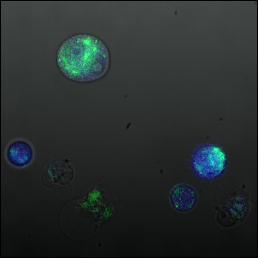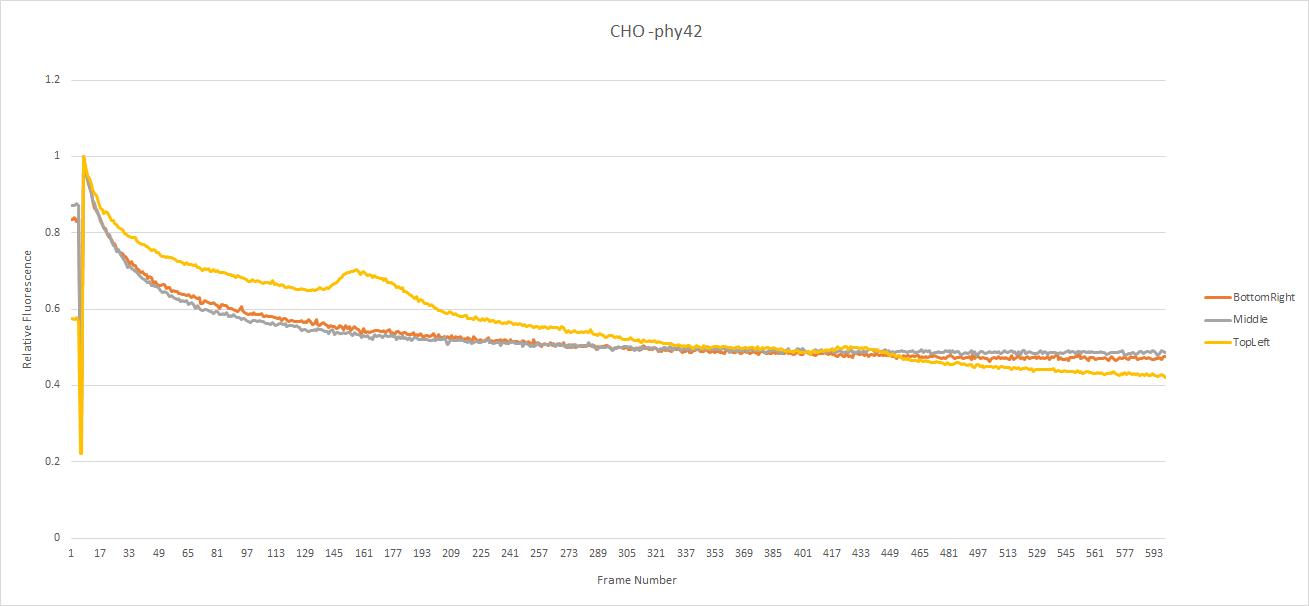Contents |
Transfections
To test whether our transfections worked, we have also cotransfected controls with 5% GFP (i.e. 5% of the inserted DNA is GFP). Over multiple experiments, we have found the transfection efficiency to vary between 20 and 50% (measured using a flow cytometer), which means the transfections are working very well. The following image was taken with a fluorescence microscope. The fluorescence clearly colocalizes with the cells (mouse-over to switch between normal and fluorescent microscopy images):


Flowcytometry
Detecting LovTAP
The Lov domain contained in LovTAP has certain fluorescent properties (Kasahara2002). It has excitation peaks around 380nm and 480nm and an emission spectrum with a peak at 500nm. We tried to use this property to detect the presence and the localization of LovTAP.
Using fluorescence microscopy, we looked at the fluorescence at 500nm
when excited at 380nm (blue in the image) and at 488nm (green in the
image). While the green fluorescence has a certain amount of specificity
(it seems to appear consistently around the nucleus), there is no significant
difference between LovTAP transfected cells and cells transfected with other
plasmids or non-transfected cells.
Characterizing LovTAP
Non-leakage DsRed, where art thou?
Melanopsin Calcium Imaging
By using timelapse photography and fluorescence microscopy we were able to study the influx of calcium into CHO cells. The cells were stained with a calcium activated dye that fluoresces green, oregon green ( OGB-1/AM ), and exposed to blue light under the microscope.
The CHO seed cells show the expected response to light exposure. The dye is bleached and its intensity gradually decreases along an exponential curve over time. This would seem to indicate the concentration of calcium in the cell remained constant during light exposure and the dye was gradually bleached. The green line seems to go up a bit at certain points, this is due to a cell passing over (out of focus), which increased the local brightness (but, of course, didn't change the real fluorescence).
The CHO cells transfected with PHY42 contain human melanopsin. The cells show a slow linear decrease in dye intensity. This would seem to indicate that calcium is being imported into the cytoplasm while the dye is being bleached.
[http://partsregistry.org/wiki/index.php?title=Part:BBa_K838002]
Part assembly
We planned to clone several parts we used into pSB1C3, which is the standard backbone plasmid in which parts are shipped to the [http://partsregistry.org/Main_Page Registry]. Four parts were successfully inserted based on colony PCR results followed by successful sequencing.
LovTAP-VP16: [http://partsregistry.org/wiki/index.php?title=Part:BBa_K838000 BBa_K838000]
Successfully cloned 4th of September.
LovTAP readout (RO): [http://partsregistry.org/wiki/index.php?title=Part:BBa_K838001 BBa_K838001]
Successfully cloned on 18th of September
Melanopsin: [http://partsregistry.org/wiki/index.php?title=Part:BBa_K838002 BBa_K838002] Successfully cloned on 12th of September
 "
"


